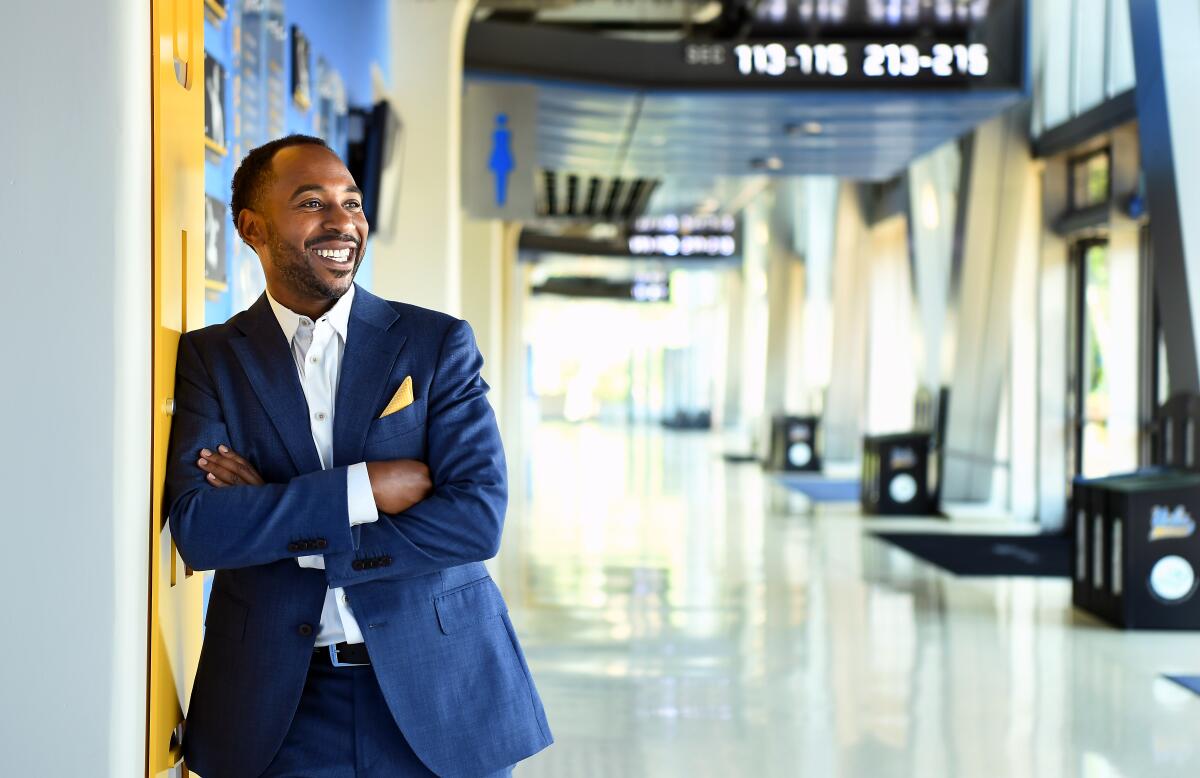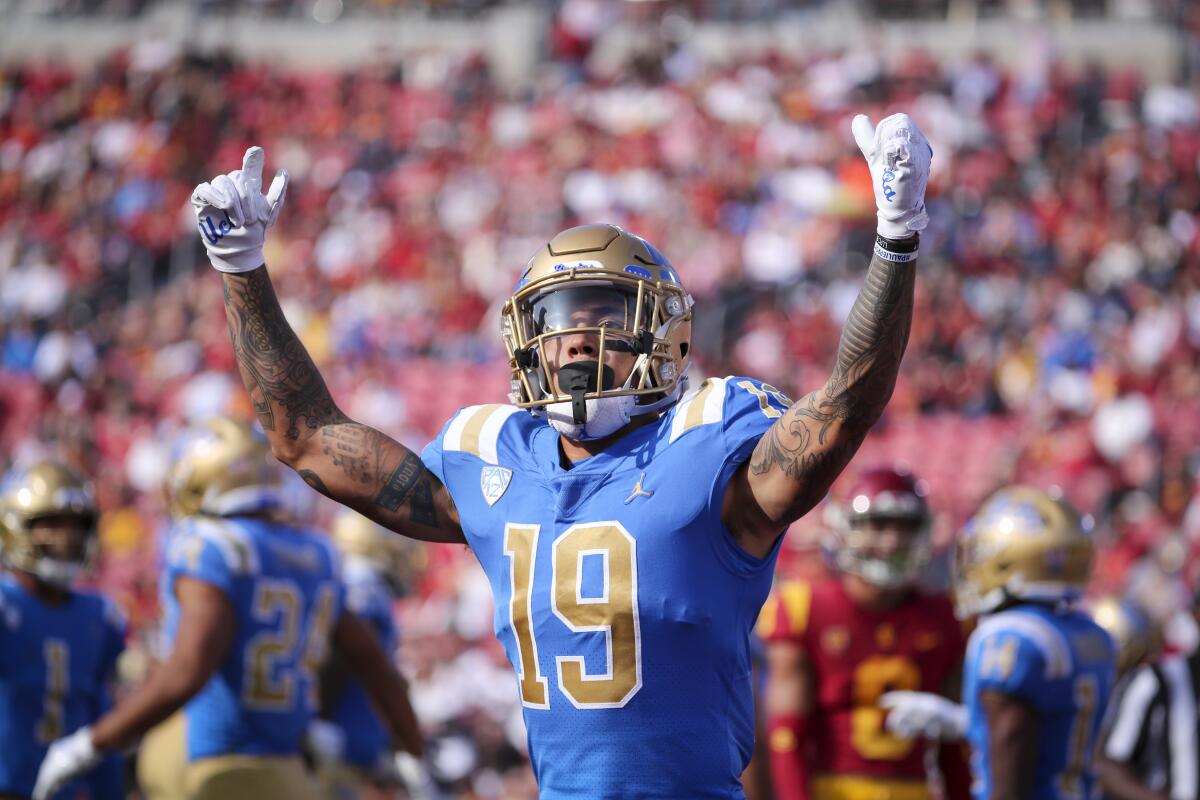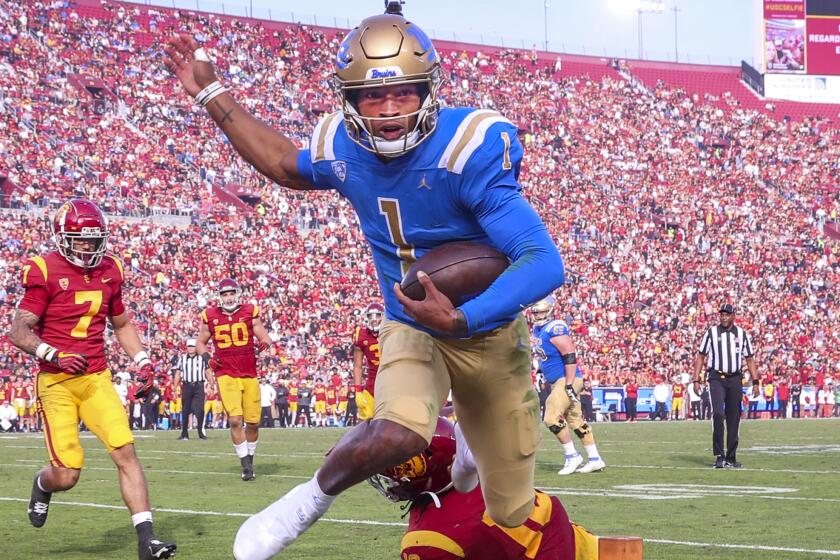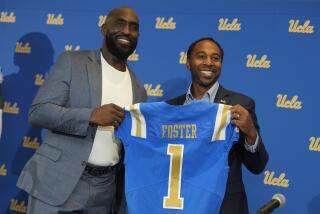News Analysis: Why UCLA’s Big Ten move is a win before kickoff for Martin Jarmond and Bruins

- Share via
UCLA’s athletic deficit crisis could be solved by a new benefactor freely spewing cash.
Its football team could move out of the massive shadows cast by those wacky late nights.
Its basketball team could go on a barnstorming tour of blue bloods, from Michigan State to Indiana to the onetime home of its greatest icon, John Wooden’s Purdue.
Two years before the Bruins play their first game as a member of the Big Ten, it feels as if they have already won big. Shedding the stale Pac-12 for a conference that will provide more money, exposure and prestige might be the latest innovation from the school that produced pioneers Jackie Robinson, Arthur Ashe and Ann Meyers Drysdale.
USC and UCLA are leaving the Pac-12 for the Big Ten, a shift that will move college football’s ‘Power Five’ closer to a ‘Power Two.’
“College athletics is changing, and UCLA has always led in times of change,” Bruins athletic director Martin Jarmond told The Times after its conference switcheroo alongside USC starting in 2024 was officially announced. “For the sake of our student-athletes, and for preserving the legacy of Bruin excellence, we cannot afford to stand still.”
This is about the future, and erasing the financial sins of the past. UCLA’s record $102.8-million athletic department deficit that has been piling up for three years could soon be history. In the final fiscal year before the COVID-19 pandemic, most Big Ten schools received a $54.3-million payout that was nearly twice that of its Pac-12 counterparts’ $33.6 million.
That financial windfall awaiting the Bruins figures to only mushroom once the Big Ten agrees to a new media-rights deal that could push $1 billion per year. That means more resources for the school’s 25 varsity teams and more than 700 athletes.
Perhaps no one inside the UCLA or USC athletic departments knows better than Jarmond what Big Ten membership will entail. He was an athletic administrator for 15 years in the conference, including eight years at Ohio State and seven at Michigan State before taking the Boston College job that led to his current post in 2020.
For starters, it means UCLA athletes will literally be playing on a national stage, with games in three time zones stretching from the Pacific to the Atlantic oceans.

“The brand exposure for our student-athletes is significant,” Jarmond said, “and you may have opportunities in name, image and likeness than you couldn’t imagine before. I’m excited about what this means for our student-athletes in being able to showcase their talent.”
It’s true that the additional travel burden involved in the nation’s only coast-to-coast conference could result in more missed class time, not to mention more time spent on airplanes. But if the hybrid learning models of the last few years have taught us anything, it’s that creative solutions are possible.
“There was considerable thought and deliberation about the travel component,” Jarmond said. “I do understand the increase in travel. That said, the Big Ten will work with us as we move forward with scheduling and different things to help in this area.”
USC and UCLA are leaving the Pac-12 for the Big Ten Conference in 2024, the two schools announced Thursday.
Michigan will presumably return to UCLA’s football schedule after backing out of a home-and-home series with the Bruins scheduled for 2022 and 2023, part of what figures to be a significant uptick in interest in games at the Rose Bowl. With Wisconsin, Penn State and Nebraska also becoming regular visitors, that giant tarp covering the upper reaches of one end zone to mask empty seats might be replaced with fans reinvigorated by new rivalries and earlier kickoffs scheduled to accommodate a national audience.
Those who still consider UCLA a basketball school should be smiling as well. The loss of the Arizona rivalry will be more than offset by the addition of so many more marquee conference games, not to mention available NCAA tournament bids. Last season, the Pac-12 put three teams in the NCAA tournament. The Big Ten? Nine.
That means the Bruins can afford a few more stumbles during conference play without worrying about where they might leave them on Selection Sunday. Also imagine the new coaching rivalries such as UCLA’s Mick Cronin versus Michigan State’s Tom Izzo, with the teams having memorably met in the game that sparked the Bruins’ 2021 Final Four run.
“Obviously, leaving the Pac-12 is bittersweet for UCLA, especially for our older Bruins,” Cronin said. “That said, the landscape of college athletics is changing dramatically and our move to the Big Ten is in the best long-term interest of our university moving forward.
“Big Ten basketball has been leading the country in putting the most teams in the NCAA tournament and that is a plus. The exciting new rivalries and opponents coming to Pauley Pavilion will be awesome for our fans. We also get to preserve the great games with our cross-town rival USC.”
This move also will give UCLA increased access to the recruiting hotbeds in Chicago, New York and throughout the Midwest, where Cronin has already established deep ties. Prospects from those areas who had previously been reluctant to go to school in Southern California because it’s so far from home now can play in front of their families at least once a season.
Characterizing the move that will extract his school from the conference it has resided in for decades, Jarmond called it a big day for UCLA athletics. What’s more enticing is that it leaves better days to come for an athletic department desperately in need of this shakeup.
More to Read
Go beyond the scoreboard
Get the latest on L.A.'s teams in the daily Sports Report newsletter.
You may occasionally receive promotional content from the Los Angeles Times.








